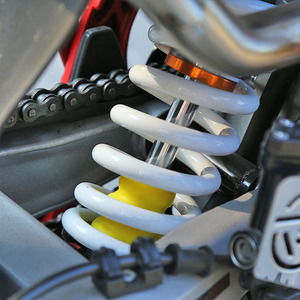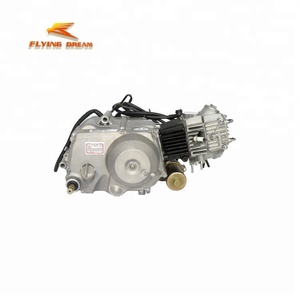(22870 products available)





















































































































































































































































The 4-stroke motorcycle engines are the most common engines in motorcycles. These are internal combustion engines that generate power in four distinct piston strokes. Here are the common types of 4-stroke engines:
Motorcycle engines are measured in cubic centimeters (cc) or liters (L). The engine displacement is the volume of air/fuel mixture the engine can burn, which indicates how powerful the engine is. A higher engine displacement means more power and torque.
Horsepower (hp) is a measure of power. It shows how fast and how much work an engine can do. An engine with more horsepower can do more work than an engine with less horsepower.
Torque is the force that makes the wheels spin. It is measured in pound-feet (lb-ft) or Newton-meters (N-m). An engine with more torque can accelerate faster and climb hills easier than an engine with less torque.
The compression ratio is how much the air/fuel mixture is squeezed in the engine's cylinders. It is the ratio of the largest volume to the smallest volume in the cylinders. A higher compression ratio makes the engine more powerful and efficient.
The engine configuration is how many cylinders the engine has and how they are arranged. The most common configurations are single-cylinder, twin-cylinder, three-cylinder, four-cylinder, V-twin, and V4. More cylinders make the engine run smoother and have more power.
The fuel system is how the engine gets fuel. It includes the fuel tank, fuel pump, fuel injector, and carburetor. The two main types of fuel systems are fuel injection and carburetion. Fuel injection is more precise and efficient than carburetion.
The cooling system keeps the engine from getting too hot. It includes the radiator, water pump, and thermostat. The two main types of cooling systems are air-cooled and liquid-cooled. Liquid cooling is better at keeping the engine cool than air cooling.
The valvetrain controls the air and fuel going in and out of the engine's cylinders. It includes the camshaft, valves, and valve springs. The two main types of valvetrains are SOHC (Single Overhead Camshaft) and DOHC (Double Overhead Camshaft). DOHC can open and close the valves quicker than SOHC.
The ignition system makes a spark to light the air/fuel mixture in the engine's cylinders. It includes the spark plug, ignition coil, and CDI (Capacitor Discharge Ignition). The ignition timing needs to be set right for the engine to work properly.
Regular maintenance is essential for the 4 stroke 250 dirt bike motorcycle engine to keep running smoothly and last a long time. Follow the maintenance schedule in the owner's manual. Change the engine oil and oil filter regularly to keep the engine's moving parts from rubbing together and wearing out. The type of engine oil to use and how often to change it are in the owner's manual. The air filter needs to be checked and cleaned or replaced to keep dirt out of the engine and help it run. The spark plug makes a spark to light the air and fuel in the engine's cylinders. Over time, the spark plug can get dirty or worn out and not work as well. The spark plug needs to be checked, cleaned, and replaced as needed. The timing chain or belt needs to be checked and adjusted to keep the engine's moving parts working together. The engine valves need to be checked and adjusted so the engine runs smoothly. The cooling system needs to be checked and the coolant changed so the engine doesn't get too hot. The carburetor or fuel injection system needs to be cleaned and adjusted so the engine gets the right amount of fuel and air to run smoothly. Checking the battery, lights, brakes, and tire pressure and tread is important for safety and to keep the motorcycle running properly. Following the maintenance schedule in the owner's manual and doing regular maintenance helps the yz 250 4 stroke motorcycle engine run smoothly and last a long time.
Inspecting the reliability and durability of the 4-stroke motorcycle engine is important. Business buyers need to ensure that the engine can withstand heavy use and last longer. Generally, engines made of high-quality materials have greater strength and tend to be more durable. It is also important to look at the engine's components and design. A reliable 4-stroke motorcycle engine with sturdy and durable parts is less likely to have wear and tear, reducing the need for frequent repairs and replacements.
Business buyers will have to consider the power and performance of the 4 stroke bike engine. They can assess the engine's power by looking at the engine displacement. Models with higher engine displacement generate more power and are more suitable for heavy work. Moreover, they can compare the horsepower and torque of the engine. Business buyers looking for engines that provide rapid acceleration and high speed should choose a 4-stroke motorcycle engine with high horsepower and torque. Additionally, they can look at the engine's compression ratio. Higher compression ratios deliver better performance.
Business buyers need to find a balance between quality and price. While it is tempting to go for the cheapest 4-stroke motorcycle engines, they should be cautious as the engines may not have the desired quality and performance. Instead, they should opt for mid-range engines, which offer a competitive balance between quality and price.
Business buyers should explore the after-sales services provided by different manufacturers or suppliers. They can check if the suppliers offer warranties, technical support, or spare parts replacement. Opting for a manufacturer that offers after-sales services ensures they get assistance in case of problems with the 4-stroke motorcycle engine.
Business buyers, especially those who operate a fleet of motorcycles, will consider the fuel efficiency of the 4-stroke motorcycle engine. Fuel-efficient engines will help reduce the overall operating costs of the business. They can check the engine specifications or look at customer reviews to assess the fuel efficiency of different engine models.
Business buyers can evaluate the environmental impact of the 4-stroke motorcycle engines. They should opt for engines that comply with emission regulations and are environmentally friendly. Choosing engines with low emission levels will help reduce the impact on the environment and also ensure compliance with local regulations.
It's important to have the right tools before attempting to replace a 4-stroke motorcycle engine. These include screwdrivers, a socket set, an engine hoist, a gasket scraper, a torque wrench, and a new engine oil. A repair manual or guidebook for the specific motorcycle being worked on is also crucial. Safety gear like gloves and goggles is an additional necessity.
First, the engine covers and mounts are removed with a ratchet and socket. Then, the clutch cable and gear shift linkages are disconnected. After that, the exhaust system is unbolted and removed. Once the wiring and hoses are disconnected, the old engine can be taken out using an engine hoist.
Afterwards, the new engine is installed in the same way the old one was removed. All wires and hoses are reconnected, and the exhaust system is reinstalled. The clutch cable and gear shift linkages are also reconnected.
A gasket scraper is used to remove old gasket material from the engine covers. New gaskets and seals are installed to prevent oil leaks. Finally, the engine oil is refilled to the recommended level.
Q1: What distinguishes a 4-stroke engine from a 2-stroke engine?
A1: The 4-stroke engine is distinct from the 2-stroke engine in that the former has four successive steps in the power cycle, while the latter has two. The 4-stroke engine has an intake, compression, combustion, and exhaust, while the 2-stroke engine has a compression-combustion and exhaust-intake.
Q2: What type of fuel do 4-stroke engines utilize?
A2: In comparison to 2-stroke engines, 4-stroke engines use cleaner fuel that has higher combustion efficiency. Gasoline, which is commonly available at fuel stations, is the most common fuel for 4-stroke engines.
Q3: What are the main advantages of 4-stroke engines?
A3: 4-stroke engines have several advantages, including fuel efficiency, improved combustion, and reduced emissions. These qualities make 4-stroke engines ideal for daily driving and complying with environmental regulations.
Q4: What are the key differences between 4-stroke and 2-stroke engines?
A4: In contrast to 2-stroke engines, 4-stroke engines have a more complicated design, with four steps in the power cycle, including intake, compression, combustion, and exhaust. They are also heavier and more expensive to manufacture.
The web search volume for the keyword "4 stroke motorcycle engines" shows a significant increase over the past year, with an average monthly web search volume of 50. This keyword experienced an 80% increase both in the three-month and one-year change metrics, reflecting growing interest in this category.
Analyzing the web search volume data month-by-month reveals a fluctuating trend, with notable peaks and valleys. For instance, the web search volume remained stable at 50 in December 2023 and January 2024, then dipped to 40 in February and March. A notable increase occurred in May 2024, reaching 70 web searches, followed by a drop back to 40 in June. The volume stabilized again in July and August at 50 web searches, and then saw a sharp increase to 90 web searches from September to November 2024.
This pattern suggests a seasonal influence on search behavior, possibly linked to specific times of the year when motorcycle enthusiasts engage more in engine upgrades or replacements. The peaks in May and from September to November could correspond to pre-summer and pre-winter preparations, respectively, when riders might be looking to enhance or service their motorcycles. Overall, the data indicates a robust interest in 4-stroke motorcycle engines, with periodic spikes that could be further explored for deeper market insights.